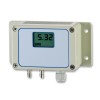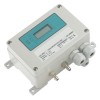 Product selection & help guide for measurements on a HVAC systems in buildings & laboratories.
Product selection & help guide for measurements on a HVAC systems in buildings & laboratories.
HVAC is the acronym for Heating, Ventilation and Air Conditioning. It is a term often used to describe a piece of equipment which is specially designed for use in an environmental control system for a building, room or a vehicle.
 Draft Pressure Sensors - Low range pressure transducers and transmitters for measuring draft air pressure in air handling systems.
Draft Pressure Sensors - Low range pressure transducers and transmitters for measuring draft air pressure in air handling systems.
Questions & Answers on HVAC applications
Laboratory to hallway negative pressure
We wish to monitor the pressure in a laboratory space to insure that HVAC system is maintaining pressure at slightly negative compare to ambient and hallways.
The DPS is a low range differential pressure sensor which can measure low level negative pressure such as the ones generated between laboratory spaces and hallways.
Related Help Guides
- Measuring the difference in air pressure between rooms
- What affects the performance of low pressure sensors
Related Technical Terms
- g Effect
- inH2O – Inches of Water Column at 4 deg C Pressure Unit
- mmH2O – Millimetres of Water Column at 4 deg C Pressure Unit
- oz/in² – Ounce per Square Inch Pressure Unit
- Pa – Pascal Pressure Unit

